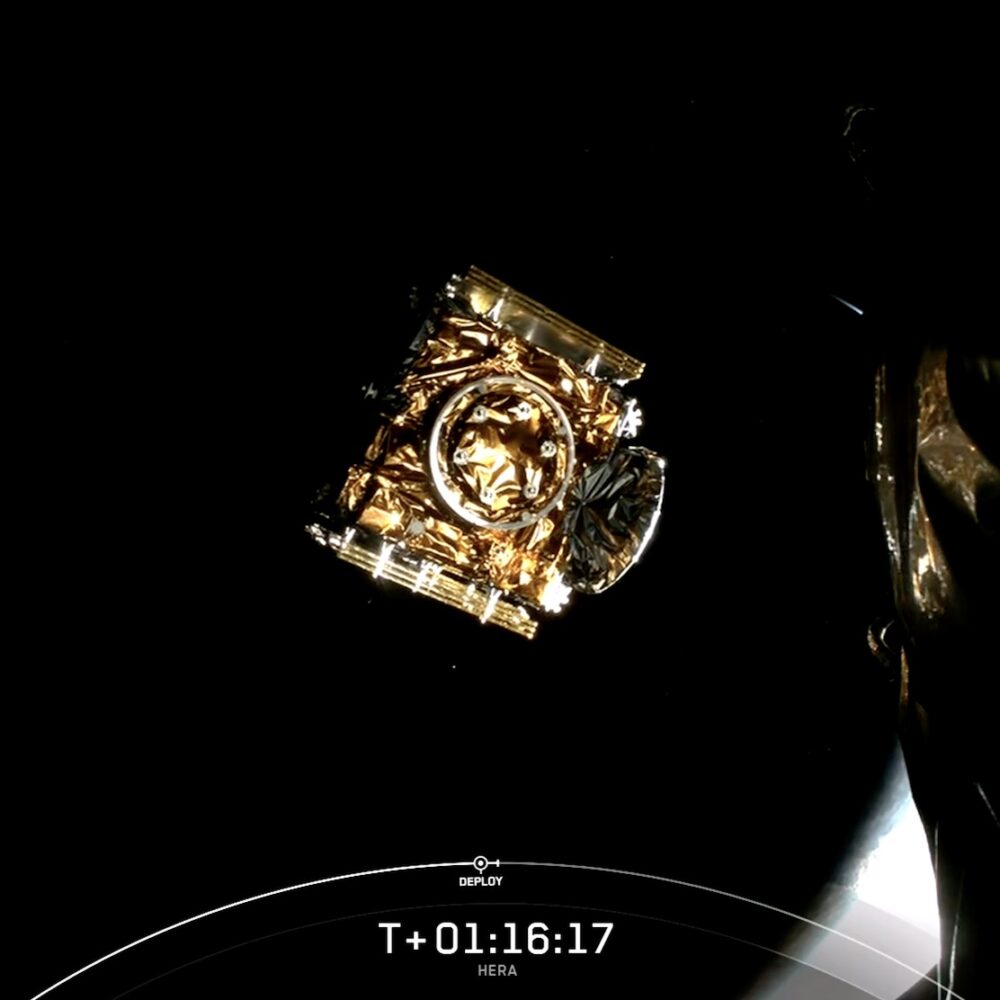October 2024
HERA on its way: Europe writing the next chapter of space history with HPS antenna
On Monday, October 7, 2024, the mission that will put Europe ahead of science fiction was launched in Cape Canaveral, Florida, on board a SpaceX Falcon 9 with the HERA satellite. After around three years of flight into deep space, the satellite will begin in 2027 to precisely document the consequences of the impact of the American DART mission to deflect the trajectory of the asteroid Dimorphos.
A central element of the HERA satellite is the X-band system from the German antenna specialist HPS (Munich): a complete antenna with a diameter of 1.2 meters made of highly stable carbon fibres, high eigenfrequenz with good reflectivity and also extremely low weight. For HPS, with its experience from major antenna projects such as the Euclid (ESA, direct client TAS-SP) and Heinrich-Hertz (DLR, direct client TESAT/OHB) missions, the antenna is proven technological terrain. Nevertheless, as the only link for scientific data between the satellite and the earth, the HPS antenna plays an enormously important role for the entire mission.
With a total mass of just 7.5 kg, it is basically a scaled-up version of the model that HPS built for ESA’s Euclid observatory, which already operates 1.5 million km from Earth. However, Hera’s antenna will have to cover much greater distances than Euclid, as it will transmit and receive over a maximum of 400 million km. To accomplish this, HPS’s high gain antenna amplifies its signal by more than 4000 times to reach Earth, focused to just half a degree, so that the entire spacecraft moves to align with its home planet.
For the flight and mission, the high-gain antenna is mounted on the outside of the spacecraft. There, it is thermally insulated from the extreme temperatures in space with a Kapton germanium sunshield, while the radio waves continue to pass through. “As engineers, we are known for staying focused on the facts and cool as Mr. Spock when dealing with the challenges facing our technology; but when the time actually comes for Europe to write space history with our antenna, then we too can be very proud and emotional,” said Ernst K. Pfeiffer, CEO of HPS.
Also, HPS-CTO Paolo Zolla was moved when he witnessed the launch live at Vandenburg Spaceport, California: “The launch was thrilling since our arrival in Florida, when the police officer at the airport told us a big hurricane will come soon. On launch day, it was raining really hard and the wind was blowing super strong. We thought the launch might get canceled. But then, just a few minutes before it was time to go, the rain stopped and the wind calmed down. The launch director said, ‘We’re good to go!’
The Falcon 9’s liftoff was a dramatic sight. Its nine engines ignited, slowly lifting the rocket before it rapidly accelerated, leaving a trail of flame and smoke. The ground rumbled as the rocket soared into the sky. Watching it disappear over the clouds, with the HERA spacecraft and ‘our’ antenna aboard, left a lasting impression—a mix of pride and the feeling of being part of an extraordinary mission.”



August 2021
HPS receives final GO to build HERA antenna which is to broadcast deep space showdown in 2024
The first defense mission of planet Earth against asteroid aggressors from space will be broadcasted live through an antenna in deep space built by Munich-based aerospace company HPS. It prevailed in two competitive preliminary design phase contracts within Europe.
Experts are convinced that the HPS model offers the highest possible signal stability thanks to its extreme resistance to deformation in orbit and OHB Bremen, prime of the ESA mission, submitted this week the respective „Approval to proceed“ (ATP) to HPS for the rest of the development. The antenna must be delivered in November 2022 for the mission start in 2024. The schedule is tough: the critical design review will take place as early as September.
See also full story here: https://www.hps-gmbh.com/hera-high-noon-in-deep-space/

